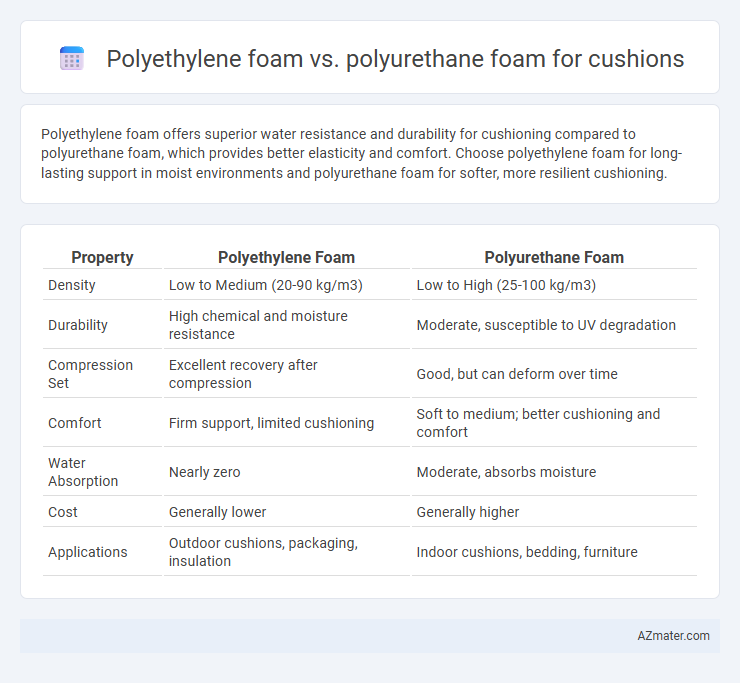Polyethylene foam offers superior water resistance and durability for cushioning compared to polyurethane foam, which provides better elasticity and comfort. Choose polyethylene foam for long-lasting support in moist environments and polyurethane foam for softer, more resilient cushioning.
Table of Comparison
| Property | Polyethylene Foam | Polyurethane Foam |
|---|---|---|
| Density | Low to Medium (20-90 kg/m3) | Low to High (25-100 kg/m3) |
| Durability | High chemical and moisture resistance | Moderate, susceptible to UV degradation |
| Compression Set | Excellent recovery after compression | Good, but can deform over time |
| Comfort | Firm support, limited cushioning | Soft to medium; better cushioning and comfort |
| Water Absorption | Nearly zero | Moderate, absorbs moisture |
| Cost | Generally lower | Generally higher |
| Applications | Outdoor cushions, packaging, insulation | Indoor cushions, bedding, furniture |
Introduction to Foam Cushions
Polyethylene foam and polyurethane foam are commonly used materials for cushion applications, each offering distinct properties for comfort and durability. Polyethylene foam provides excellent resilience, moisture resistance, and lightweight cushioning, making it ideal for outdoor and water-exposed environments. Polyurethane foam delivers superior softness and support with higher density options, commonly used in furniture and bedding for enhanced comfort and pressure relief.
What is Polyethylene Foam?
Polyethylene foam is a closed-cell, lightweight material known for its excellent cushioning, shock absorption, and water resistance properties. It offers superior durability and resistance to chemicals, making it ideal for protective packaging and high-impact cushioning applications. Unlike polyurethane foam, polyethylene foam provides enhanced moisture resistance and greater structural stability under repeated stress.
What is Polyurethane Foam?
Polyurethane foam is a versatile cushioning material made from polymer chains formed by reacting polyols and diisocyanates, known for its excellent durability and energy absorption. It offers superior comfort and support compared to polyethylene foam due to its open-cell structure, which enhances breathability and resilience. Commonly used in furniture, mattresses, and automotive seating, polyurethane foam provides enhanced shock absorption and long-lasting performance.
Key Differences Between Polyethylene and Polyurethane Foams
Polyethylene foam offers higher density and better impact resistance, making it ideal for heavy-duty cushioning and packaging applications, while polyurethane foam provides superior softness and flexibility for comfort-focused uses like upholstery and mattresses. Polyethylene foam is closed-cell, providing excellent water resistance and durability, whereas polyurethane foam is typically open-cell, offering greater breathability but lower moisture resistance. Cost differences also play a role; polyethylene foam tends to be more expensive due to its toughness and longevity, whereas polyurethane foam is more affordable and versatile for various cushioning needs.
Cushioning Performance Comparison
Polyurethane foam offers superior cushioning performance due to its higher density and resilience, providing better support and pressure distribution compared to polyethylene foam. Polyethylene foam is more rigid and has a slower recovery rate, making it less effective for prolonged cushioning applications. In terms of durability and comfort, polyurethane foam outperforms polyethylene foam, making it the preferred choice for high-quality cushions.
Durability and Longevity
Polyethylene foam exhibits superior durability compared to polyurethane foam due to its closed-cell structure, which resists compression and maintains shape over extended use. Polyurethane foam, while softer and more flexible, tends to degrade faster under continuous pressure, leading to reduced longevity in cushioning applications. For long-term performance in cushions, polyethylene foam is often preferred due to its resistance to wear, moisture, and chemical breakdown.
Comfort and Support Levels
Polyurethane foam offers superior support and better conforms to body contours, providing enhanced comfort for prolonged seating compared to polyethylene foam. Polyethylene foam is firmer and more resilient but tends to offer less cushioning and pressure relief, making it suitable for lightweight or temporary seating solutions. The choice between these foams depends on desired comfort level and durability, with polyurethane foam favored for high-comfort cushions and polyethylene foam for firm support.
Cost Analysis
Polyethylene foam typically offers a lower cost per volume compared to polyurethane foam, making it a budget-friendly choice for cushion applications where durability and water resistance are prioritized. Polyurethane foam, while generally more expensive, provides superior comfort and better cushioning properties due to its higher density and flexibility, which can justify the cost in premium furniture or automotive seating. Evaluating the total cost of ownership involves considering not only the initial material price but also lifespan, maintenance, and application-specific performance requirements.
Applications in Cushioning
Polyethylene foam offers excellent impact absorption and moisture resistance, making it ideal for protective packaging and sports equipment cushioning, while polyurethane foam provides superior comfort and pressure distribution, commonly used in furniture and mattress cushions. Polyurethane foam's ability to conform to body shape enhances ergonomic support, whereas polyethylene foam's durability benefits industrial cushioning applications. Both materials serve distinct roles in cushioning, with polyethylene prioritized for durability and polyurethane favored for comfort.
Which Foam is Best for Cushions?
Polyurethane foam offers superior comfort and support for cushions due to its higher density and resilience, making it ideal for long-term use and pressure distribution. Polyethylene foam, while lightweight and moisture-resistant, lacks the same cushioning properties and tends to be firmer, which may be less comfortable for prolonged seating. Choosing polyurethane foam ensures better durability and cushioning performance, especially in furniture applications requiring soft, yet supportive padding.

Infographic: Polyethylene foam vs Polyurethane foam for Cushion
 azmater.com
azmater.com